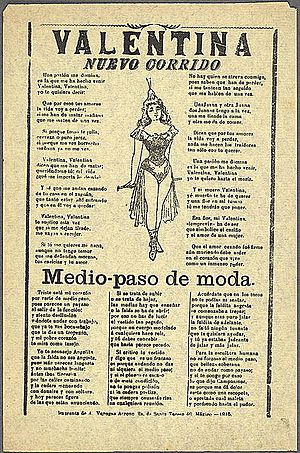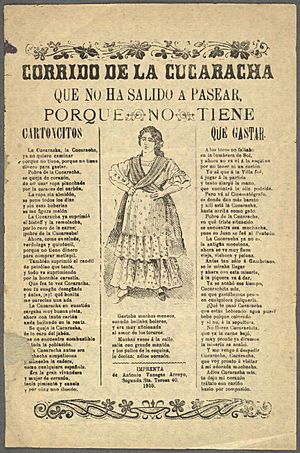Corrido facts for kids
A corrido is a special type of Mexican song that tells a story. Think of it like a musical story or a sung poem! These songs are often about important events, brave heroes, or even everyday life. They can talk about history, challenges people face, or the life of a vaquero (a Mexican cowboy).
Corridos became very popular during the Mexican Revolution (1910-1921). They were also well-known in the Southwestern United States, helping to shape Tejano music and New Mexico music. These styles later influenced Western music too.
A typical corrido usually starts with the singer saying hello, then a short introduction to the story. After that comes the main story, and finally, a lesson or a farewell from the singer. Corridos are still a popular type of music in Mexico today. You can also find them in Chile during their national celebrations called Fiestas Patrias.
Contents
History of Corridos
Corridos are a very important part of Mexican and Mexican American culture. The word corrido comes from the Spanish word correr, which means "to run." This might refer to how the stories "run" through the song.
These story-songs have a long history in Mexico. They started around the time of the Mexican War of Independence (1810-1821) and became very popular during the Mexican Revolution (1910-1921). Before radio and TV became common, corridos were a main way for people in Mexico to get news and learn about events. They were easy to understand and remember, so people could share them by singing. Sometimes, they even carried secret messages or news that the government didn't want people to hear!
After radio and TV became widespread in the mid-1900s, corridos changed. But they are still evolving today. In some rural areas, where Spanish and Mexican cultures have stayed strong, you can find older forms of story-songs. For example, in New Mexico, a song called an Indita developed. It's like a corrido but is chanted, similar to some Native American songs.
The very first corridos were often based on old Spanish stories or European tales. These early songs were usually about love or religious topics. They had a simple style, often with a quick tempo and short lines.
The genre really grew during the Mexican War of Independence and especially during the Mexican Revolution. This is when corridos became "epic" and started to have their famous three-part story structure.
Some corridos are beautiful love stories. Not just about men, but also about women, like "La Venganza de Maria" or "La Adelita." Some even tell made-up stories created by the songwriters.
Before radio, corridos were passed around by word of mouth. They were a great way to share news about events, famous heroes, and even jokes. Many people couldn't read back then, so these songs were very important for sharing information. During the Mexican Revolution, corridos were used to spread real news. This was important because the newspapers were often controlled by the government and spread propaganda.
People would buy song sheets of popular corridos. Sometimes, these sheets were given out for free to praise leaders, armies, or political ideas. They could also be used to make fun of opponents. One of the most famous Revolutionary corridos is "La Cucaracha" (The Cockroach). It was an old song that was changed to celebrate Pancho Villa's army and tease his enemy, Victoriano Huerta.
After the Mexican Revolution, the government became stronger, and mass media like radio became popular. Corridos lost their main role as a way to spread news. Instead, they became more about folk traditions or the voice of new groups. These included workers facing challenges, activists, and farm workers who moved to other countries, especially the United States.

Today, all three types of corridos—the old romantic ones, the revolutionary ones, and modern ones—are still sung. There are also similar story-song genres in Mexico, like the "valona" and the "son arribeño." Corridos are very flexible. You can even find corrido lyrics set to other types of music, like blues or ska. Some corridos are even sung in English or a mix of Spanish and English, especially by Mexican-American (Chicano) people in the United States. For example, the Teatro Campesino theater group used corridos to help organize Mexican and Mexican-American farmworkers in California in the 1960s.
Corridos have become popular again in the 21st century. Modern corridos talk about current topics like immigration, migrant work, and even the chupacabra (a mythical creature).
Types of Corridos
Corridos Tumbados
"Corridos tumbados" are a newer style of corrido that mixes traditional corrido sounds with hip-hop music. This style became very popular thanks to artists like Natanael Cano. The idea to combine these two types of music came from Dan Sanchez. He wrote Natanael's first corrido tumbado, "Soy El Diablo." Later, a remix of this song came out featuring the famous rapper Bad Bunny.
Other popular artists in this style include Peso Pluma, Fuerza Regida, and Junior H. Many of these artists say that Ariel Camacho was a big influence on their music.
Since 2023, corridos tumbados have become hugely popular all over the world. Many famous artists from other genres have worked with corrido tumbado singers. These include Eladio Carrión, Myke Towers, and the Argentinian producer Bizarrap. Bizarrap released a very successful song with Peso Pluma. As corridos tumbados grew in popularity, even major American hip-hop artists like Drake, Travis Scott, and Lil Baby have been seen with corrido tumbado musicians.
The Story of Gregorio Cortez
Gregorio Cortez was a Mexican man born in 1875 in Mexico. When he was about 12 years old, his family moved to Manor, Texas, in the United States. Later, Gregorio and his older brother, Romaldo, worked as ranch hands and farmhands in Karnes County, Texas. They were also vaqueros, skilled cowboys. In 1900, Gregorio and Romaldo both got married. They were very close.
On June 12, 1901, a sheriff named W.T. Morris came to investigate a horse theft. Gregorio and Romaldo were innocent, but there was a big problem: they spoke Spanish, and the sheriff only spoke English. The sheriff relied on poor translations from his Texas Rangers. This led to a lot of confusion.
The sheriff thought Gregorio and Romaldo were lying. He tried to arrest them for a crime they didn't commit. Gregorio stood up for himself, saying in Spanish, "You can't arrest me for nothing." The sheriff misunderstood and thought Gregorio said, "No white man can arrest me." The sheriff then shot Romaldo, wounding him. In return, Gregorio shot the sheriff. Gregorio then left the scene.
Cortez walked for many miles through tough land, trying to reach the border. Texas Rangers were chasing him. He even had to defend himself again, killing the Gonzales sheriff, Robert M. Glover. Gregorio walked about 100 miles and then rode a horse for another 400 miles towards the border. On June 22, 1901, he met a man named Jesús González. Sadly, González led the rangers to Cortez, and he was arrested. Many Mexican-Americans called González a traitor for this.
Cortez was put on trial. People from Mexico City, including the president of Mexico, sent money to help him. Gregorio was sentenced to life in prison for murder and for the supposed horse theft. However, he was freed after about a year. This outcome was seen as a big victory for Mexican-Americans. It showed that they could fight against unfair treatment. Gregorio Cortez became a hero, and his story was told in a famous corrido.
The Ballad and Impact of Gregorio Cortez
The Ballad
The Ballad of Gregorio Cortez is a very well-known corrido, especially among Mexican-Americans living near the Texas-Mexico border. It tells the exciting story of Gregorio Cortez, a Mexican man who bravely stood up against 33 Texas Rangers. The song covers the events from June 12 to June 22, 1901.
Because of this corrido, Gregorio Cortez became a folk hero along the Texas-Mexico border.
In the song, Cortez is described as a kind and hardworking man who always respected his family. Most of the story in the corrido is similar to his real life. However, the song says he was a great marksman, and his brother Romaldo is called Román in the song.
The corrido describes how Sheriff Morris questioned Román and Cortez about the horses. In the song, Román is shot and killed trying to protect his brother. Gregorio then shoots the sheriff to get revenge for his brother. The song also makes Gregorio seem like a super-strong man who ran across the country with the Texas Rangers chasing him. It says he walked 100 miles and rode over 400 miles. The corrido ends with Gregorio being betrayed by a friend named "El Teco" and arrested. He is then sentenced to "ninety-nine years and a day" in prison for horse theft, even though he never stole a horse.
Impact
The story of Gregorio Cortez shows the strong culture of Mexican-Americans in the southwestern United States. His tale was made into a corrido and passed down from person to person. Cortez became a folk hero, and his story helped inspire other tales of bravery. It also showed the "spirit of the border struggle," meaning the challenges and conflicts faced by people living along the border. Many people saw Cortez as a hero because he kept escaping the "rinches" (Texas Rangers) until he was finally caught. This gave Mexican-Americans a hero who stood up for his rights against "outsiders."
Both the real story and the corrido show how strong Gregorio Cortez was. He stood up to a legal system that was often unfair to Mexican Americans. Because of this, he became a hero to many people of Mexican descent in Texas.
The corrido has also been adapted into other forms of media. In 1958, Américo Paredes wrote a book called With His Pistol in His Hand: A Border Ballad and Its Hero. This book explains the corrido and the story of Gregorio Cortez in great detail. It has become a very important book about Mexican-American culture. In 1982, a movie called The Ballad of Gregorio Cortez was made, with Edward James Olmos playing Gregorio Cortez.
How Corridos are Played
Corridos, like rancheras (another type of Mexican music), usually start with instrumental music. They also have adornos, which are musical decorations. These parts help make space for the song's lyrics. Corridos can be played in almost all regional Mexican music styles. Also, like rancheras, corridos are often played in a polka, waltz, or mazurka rhythm.
See also
 In Spanish: Corrido (México) para niños
In Spanish: Corrido (México) para niños
- Tambora Sinaloense
- Duranguense
Images for kids





